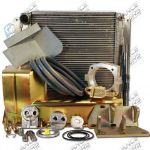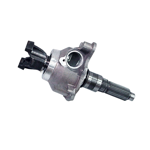The Evolution of Automatic Transmissions: From Hydraulics to Electronics
Once considered the inferior option by true car and truck enthusiasts, automatic transmissions are now common even among serious gearheads, delivering performance that even manual transmission can’t match. Many modern vehicles are only available with an automatic gearbox — and in most cases, they are more efficient and cost less than manual transmissions when you factor in the wear and tear of the moving parts. But how did we get here? Advance Adapters has a brief look at the history of automatic transmissions and how they evolved from a novelty to the new standard.
Who Invented the Automatic Transmission?
Some credit Canadian steam engineer Alfred Horner Munro with inventing the automatic transmission, whose design was patented in 1923. However, the first such transmission was actually released in 1904. Designed by the Sturtevant brothers of Boston, it had high and low forward gears with flyweights that shifted based on the engine RPM.
Regardless, both inventors’ devices were flawed. The Sturtevant transmission could not handle the forces of quick gear changes and thus failed often. As for Munro’s transmission, it operated on compressed air and thus did not have a viable power source for commercial use.
The First Hydraulic Automatic Transmission
In 1932, Brazilian inventors José Braz Araripe and Fernando Lehly Lemos developed the first prototype of an automatic gearbox that used hydraulic pressure from fluid. The duo sold the prototype to General Motors, which worked the design into the Hydra-Matic. Introduced for the 1940 model year, this is considered the first usable automatic transmission and one of the greatest achievements in automotive history.
Hydraulic technology was further developed and refined over the coming decades. In 1947, Buck released the Dynaflow, which replaced the fluid coupling with a torque converter. Then in the 1950s, BorgWarner came up with the first three-speed automatic transmission. Four-speed transmissions with overdrive rose in popularity during the early 1980s, and modern automatics can have as many as 10 speeds.
In recent years, continuously variable transmissions (CVTs) have also been widely adapted to vehicles. First conceived in 1879 by Milton Reeves, automatic CVTs replace fixed gears with a belt and variable-width pulleys, allowing for near-infinite gear ratios.
Electronic Automatic Transmissions
Some automatic gearboxes still use hydromechanical control units with throttle valves, vacuum modulators, governors and other methods. But since the late 1980s, more and more cars have electronically controlled transmissions. In these systems, electric solenoids control the clutches and bands. These solenoids are in turn operated by either the engine control unit or transmission control unit.
This has allowed for control schemes that are more and more elaborate. Instead of just tracking throttle position and speed like mechanical systems, electronic transmission controllers also can track engine speed and braking. As such, transmissions can shift more precisely for maximum power, torque and efficiency. They also adapt to common driving conditions such as downshifting when you’re driving down a steep hill.
Automatic Gearboxes and Adapters
We hope you have enjoyed this quick look at the evolution of the automatic transmission. If you need an automatic transmission adapter for your project, Advance Adapters has many applications available.
Frequently Asked Questions
Who was the first inventor of the automatic gearbox?
The first inventor of the automatic gearbox was Alfred Horner Munro, who patented a design for a fully automatic transmission in 1921.
How did the hydraulic automatic transmission come to be developed?
The hydraulic automatic transmission was developed in the 1930s by General Motors, combining a fluid coupling with planetary gears to create smooth, automatic shifting without driver input.
When did automatic transmissions start using electronic controls?
Automatic transmissions began using electronic controls in the early 1980s, improving shift precision and efficiency by integrating sensors and computer management systems.























